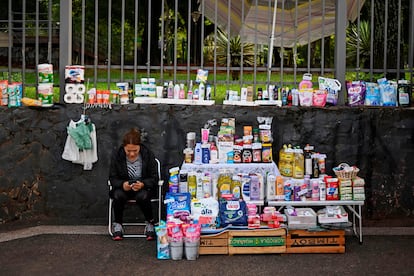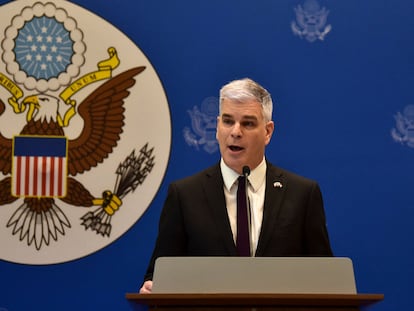Inequality: The endemic evil of Paraguay
Incoming president Santiago Peña, of the Colorado Party, is promising to create half-a-million jobs in a country that has very low tax rates and a high concentration of power in the hands of large landowners

Creating half-a-million new jobs in five years is the campaign promise that has been made by Santiago Peña, who won his country’s presidential elections this past April. It’s a promise that would be difficult to fulfill in any part of the world. But in Paraguay — which has a working-age population made up of 3.5 million people — it could be mission impossible for Peña, who leads the Colorado Party, a liberal party that has governed the South American nation throughout almost its entire history.
In his favor, the president-elect has the support of two decades of macroeconomic stability and an economy that, according to the IMF, could grow up to 4.5% this year. But the adverse conditions are at least as significant: Paraguay’s public debt that has multiplied four times over the last 10 years and tax collection is at insufficient levels. Meanwhile, the economic model — primarily based on the export of natural resources — seems to have little capacity to generate new employment.
After shrinking by as much as 0.8% in the worst year of the pandemic, Paraguay’s GDP has been in positive territory since 2021, when it recovered with a generous rebound of 4.1%. The 4.5% growth that is expected for 2023 is mostly due to the export of soybeans and beef — the main engines of an economy that is also committed to corn and agroforestry production, with increasingly lower taxation for foreign investment.
Tax collection has never been Paraguay’s strong suit, with tax revenue amounting to less than 9.5% of GDP in 2020, according to the World Bank. Comparably, neighboring Argentina and Brazil are above 30%. But the contribution of the soybean sector is even more shocking, with less than 0.16% of the sector’s revenue being collected in taxes, according to a study by economist Sarah Zevaco. And other types of produce don’t have any tax at all. “Paraguay is the only country where grain production is not taxed,” explains Alhelí González Cáceres, from the Political Economy Society of Paraguay.
Job creation is the argument used to justify the tax exemption. But the problem with Paraguay’s highly-mechanized agricultural industry is that it doesn’t require many workers. On the other hand, the concentration of land in the hands of only a few citizens prevents that wealth from being distributed to smaller landowners. According to data from the last agricultural census (2008), at least 85% of the land is in the hands of only 2.5% of the population.
Betting on extensive agricultural exploitation and logging not only threatens the redistribution of wealth: it also endangers indigenous communities, the country’s biodiversity and food sovereignty. “Safeguarding the productive diversity of the Paraguayan peasant economy is essential for feeding the vulnerable sectors and the lower middle class in the cities,” explains Dionisio Borda, who served as Finance Minister during the progressive government of Fernando Lugo (2008-2012).
In Paraguay, there is also the problem of “ill-gotten” land. This is in reference to the seven million hectares that military dictator Alfredo Stroessner — who ruled from 1954 until 1989 and was affiliated with the Colorado Party — seized and handed over to the military, politicians and friendly businessmen. A year ago, a commission was created to put these illegally obtained lands back into the hands of small farmers. So far, however, little progress has been made.
The peasant movement had some capacity to exert pressure but, during the presidency of Mario Abdo Benítez (2018-present), a law was passed that criminalized peasant protest. This has made the recovery of those ill-gotten lands even more difficult. “Small producers need government support, not only regarding the land problem — which is fundamental — but also to help them obtain credit and make technological improvements,” Borda emphasizes.
Another characteristic that distinguishes the Paraguayan economy is the gigantic flow of energy generated by two large hydroelectric plants that it shares with Argentina (Yaciretá) and Brazil (Itaipú). While partners such as Brazil have taken advantage of this cheap energy for industrial development, Paraguay has never made the necessary investments in transmission technology that would have allowed the country to adopt an economic model with greater capacity to generate employment.
In the opinion of economist Luis Rojas, the reason this industrialization effort never came about was because the Colorado Party has always preferred to sell Paraguayan energy surpluses to Argentina and Brazil to obtain resources with which to finance the state, which employs some 338,000 people as of 2022. According to Rojas, having almost 10% of the voting-age population work for the state is a winning strategy whenever election day rolls around. “The only industrialization that has occurred in recent years are the maquilas [rudimentary factories], [designed to support] industrial processes in Brazil, with very favorable laws and exemption from taxes and tariffs. This has brought many companies into Paraguay, but the transformation is minimal and, immediately after it is made, the product is exported again. No industrial process is installed,” he laments.
When he takes office this August 15, one of Peña’s urgent tasks will be to renegotiate the treaty that regulates the sale of surplus Paraguayan energy to Brazil. According to Borda, there are two key variables in this negotiation: raising a rate that has been calculated for 50 years according to the cost of production (and not by the market price) and obtaining the freedom to sell the surplus to third countries, such as Argentina or Uruguay.
“During Lugo’s government, an agreement was reached with Lula [during the Brazilian president’s previous terms in power, from 2003 until 2010], whereby the payment for the energy that Paraguay sold to Brazil went from about $120 million a year to about $360 million. But I don’t know if this will be possible [with today’s Lula, who retook office at the start of this year], because he is under great pressure from his business sector and has less flexibility,” Borda notes.
Public debt is also cause for concern. When former president Horacio Cartes (also of the Colorado Party) took office in 2013, Paraguay’s debt stood at $3.5 billion, representing 10% of GDP. And, 10 years later, it now stands at $15 billion, representing 37% of GDP. Even the IMF, says Borda — known for advocating pro-market policies — is advising the government in Asunción to increase taxes. Without more revenue, it will be impossible to clear debt and address the very serious deficiencies in public health and education. “The indirect tax on consumption [sales tax] — paid by the poor and the lower middle class — represents more than half of the tax collection at the moment,” Borda explains.
This figure seems inconceivable in a country where one in four people is poor and two out of three workers have no social protection. Borda believes that a tax reform must include a progressive income tax, “which, today, doesn’t exceed 10%, no matter how much someone is earning.” He also thinks that corporate taxes need to be raised — it stands at 8%, an extremely low figure — as does a tax on wealth. “People who speculate with land in Paraguay do so firstly because it is cheap, but also because the tax they pay for the land is negligible.”
Sign up for our weekly newsletter to get more English-language news coverage from EL PAÍS USA Edition
Tu suscripción se está usando en otro dispositivo
¿Quieres añadir otro usuario a tu suscripción?
Si continúas leyendo en este dispositivo, no se podrá leer en el otro.
FlechaTu suscripción se está usando en otro dispositivo y solo puedes acceder a EL PAÍS desde un dispositivo a la vez.
Si quieres compartir tu cuenta, cambia tu suscripción a la modalidad Premium, así podrás añadir otro usuario. Cada uno accederá con su propia cuenta de email, lo que os permitirá personalizar vuestra experiencia en EL PAÍS.
¿Tienes una suscripción de empresa? Accede aquí para contratar más cuentas.
En el caso de no saber quién está usando tu cuenta, te recomendamos cambiar tu contraseña aquí.
Si decides continuar compartiendo tu cuenta, este mensaje se mostrará en tu dispositivo y en el de la otra persona que está usando tu cuenta de forma indefinida, afectando a tu experiencia de lectura. Puedes consultar aquí los términos y condiciones de la suscripción digital.
More information
Archived In
Últimas noticias
There is as much life left to discover on planet Earth as that which is already known
Dozens presumed dead, around 100 injured in fire at Swiss Alps bar during New Year’s celebration
Is porn for women different from conventional porn? We spoke to those who make it
Cartagena de Indias is sinking: What can the city do to mitigate it?
Most viewed
- Reinhard Genzel, Nobel laureate in physics: ‘One-minute videos will never give you the truth’
- David King, chemist: ‘There are scientists studying how to cool the planet; nobody should stop these experiments from happening’
- Sinaloa Cartel war is taking its toll on Los Chapitos
- Oona Chaplin: ‘I told James Cameron that I was living in a treehouse and starting a permaculture project with a friend’
- The Interoceanic Train, the Mexican alternative to the Panama Canal









































